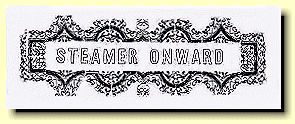
![]()
![]()


|
| Yale, the head of Navigation on the Fraser River
(BC Archives: PDP-01783) |
The discovery of gold in 1858 at Hill's Bar, two miles south of Yale, caused the first massive influx of people into the Lower Fraser River Region. The majority of people came from the California Gold Rush, landed in Fort Victoria and travelled across the Gulf and up the Fraser River.
Once the Lower Fraser Rush was exhausted new discoveries began to take miners to the waters of the Upper Fraser and its tributary creeks. The Fraser River above Yale; however, was too rough for steamboats to navigate through, and so Yale, located at the head of navigation, became an important transfer point for traffic heading north to the Cariboo Gold Rush.
All passengers and freight bound for the Cariboo passed through Yale, creating another boom for the transportation industry and local businesses. Freighting and forwarding on the Cariboo Wagon Road became a great business of the town and many companies were engaged in it. The Royal Engineers, a group of about 200, became quite influential in B.C. due to their frustrations over the lack of easy transportation.
Construction of the railroad through Yale and up to the Cariboo created the third and last boom that the historic town experienced. Andrew Onderdonk's contract with the CPR made Yale the construction headquarters for the stretch of railway which was to snake its way through the Fraser Canyon. Onderdonk successfully pushed the ribbon of steel through the Fraser Canyon, and the railway's completion marked the doom of river traffic and Historic Yale (T.W. Paterson. Fraser Canyon . P.70).

Rafting the Grand Canyon along the Upper Fraser
(Royal British Columbia Museum Photo No:12566)

Steamer Onward Receipt
(BC Archives: MS 1894)
Home| Contents| Tour| People| Collection| Transportation| Just For Kids!| Team